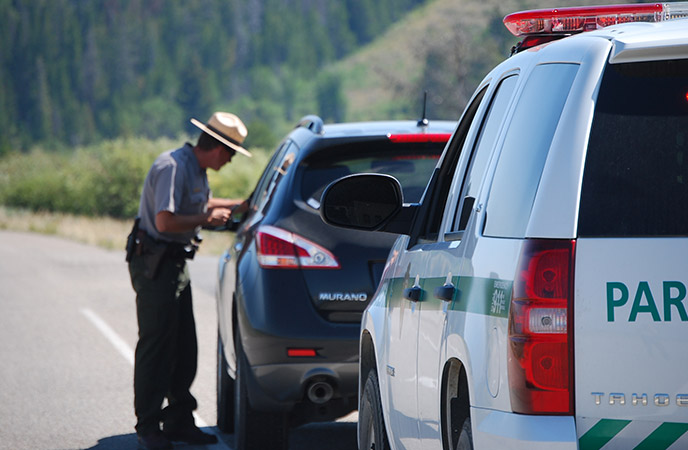 Grand Teton National Park and John D. Rockefeller, Jr. Memorial Parkway Superintendent’s Compendium
Grand Teton National Park and John D. Rockefeller, Jr. Memorial Parkway Superintendent’s Compendium
Superintendent’s Compendium. 2024. Temporary & Wildlife Closures. Updated as needed.
Additional regulations are contained in the Code of Federal Regulations.
Things to Know
For a safe and enjoyable visit, please know these park regulations and safety advisories. For more regulations see Grand Teton Superintendents Compendium and Code of Federal Regualtions above.
Launching, landing, or operating an unmanned aircraft, such as a drone, is prohibited.
Pets must be restrained on a leash (6 feet or less) and stay within 30 feet of roadways. Owners must properly dispose of feces. Pets are not allowed in visitor centers, on ranger-led activities, on the multi-use pathway, or on park hiking trails. Pets are ONLY allowed in boats on Jackson Lake—no other waterways.
Service animals must assist with a disability and must be trained to perform tasks to aid with the disability. Dogs whose sole function is providing comfort or emotional support do not qualify as service animals under the Americans with Disabilities Act. Visitors who plan to take a service animal into the backcountry should complete an acknowledgment form in a visitor center at their convenience.
Leave what you find. Keep items in their natural setting for others to enjoy. Picking wildflowers, historic objects, archaeological artifacts, natural features, or collecting items such as antlers is prohibited. Edible fruits, berries, mushrooms, and nuts may be gathered by hand for personal use and consumption. The allowable limit is one quart/per species/per person/per day.
Campfires are allowed at designated campgrounds and picnic areas within metal fire grates, unless fire restrictions are in effect. Fires are prohibited in other areas. Fireworks and other pyrotechnic devices are prohibited at all times.
Wyoming state firearm regulations apply. Carrying or possessing firearms is prohibited in buildings where notice is posted. Firearms may not be discharged in a national park, except by permitted individuals during legal hunting seasons.
Bicycles are permitted on public roadways and the multi-use pathway. Ride single-file on the right side of the road and wear a helmet. Riding bicycles or other wheeled vehicles in the backcountry is prohibited. Electric bicycles (e-bikes) are considered bicycles if they have fully operable pedals. Persons with physical disabilities may use addtional battery-operated transportation. The Grand Teton Pathway is a place to bicycle, walk, run, and rollerblade. Do not access the pathway from dusk to dawn for your safety and wildlife’s safety. Dogs are not allowed on the pathway. Service animals may travel on the pathway (as defined above).
Soaking in pools where thermal waters originate is prohibited to protect resources. Soaking in adjacent run-off streams is allowed, provided they do not contain an originating water source. These waters may harbor organisms that cause diseases.
Hikers should stay on trails. Short-cutting is prohibited and damages fragile vegetation promoting erosion. Know your limits. For your safety, leave your itinerary with a responsible party. Solo travel is not advised. Permits are not required for day hikes. Trailhead parking areas fill in July and August. During early summer, trails may be snow-covered and require an ice axe for safe travel. Check for wildlife closures in areas you intend to go. Visitor centers and park stores sell topographic maps and trail guides.
Use experience and good judgment when climbing or traveling in the mountains. For route and climbing information or to pick up any permit involving climbing visit the Jenny Lake Ranger Station in summer, Craig Thomas Discovery and Visitor Center in spring and fall, or go to park headquarters in Moose in winter. Registration is not required for day climbs. Backcountry permits are required for all overnight stays. Check for wildlife closures in areas you intend to go. Leave your itinerary with a responsible party. Solo travel is not advised.
Traveling in the mountains has inherent risks including potential rockfall. Serious injury or death could occur.
Skiers, snowboarders, and snowshoers should know their limitations. For safety purposes, leave an itinerary with a responsible party. Solo travel is not advised. Permits are not required for day trips. If you access the park from Jackson Hole Mountain Resort, remember the park does not perform avalanche hazard reduction work. Check for wildlife closures in areas you intend to go. The Bridger-Teton Avalanche Center posts a daily avalanche forecast at: jhavalanche.org or call 307-733-2664.
Snowmobile use is limited in Grand Teton National Park to the frozen surface of Jackson Lake with approved snowmobiles for ice fishing only (BAT approved). Snowmobiles are also allowed on the Grassy Lake Road in the John D. Rockefeller, Jr. Memorial Parkway once safe conditions exist.
National Park Service Organic Act
Passed in 1916, this law created the National Park Service and established its mission:
“to conserve the scenery and the natural and historic objects and the wildlife therein and to provide for the enjoyment of the same in such manner and by such means as will leave them unimpaired for the enjoyment of future generations.”
National Park Service Mission
The National Park Service preserves unimpaired the natural and cultural resources and values of the National Park System for the enjoyment, education, and inspiration of this and future generations. The National Park Service cooperates with partners to extend the benefits of natural and cultural resource conservation and outdoor recreation throughout the United States and the world.






![Air gun 101: The differences between .177 & .22 – Which jobs they do best ? [Infographic]](https://airgunmaniac.com/wp-content/uploads/2020/09/g44-218x150.jpg)

































 Grand Teton National Park and John D. Rockefeller, Jr. Memorial Parkway Superintendent’s Compendium
Grand Teton National Park and John D. Rockefeller, Jr. Memorial Parkway Superintendent’s Compendium




